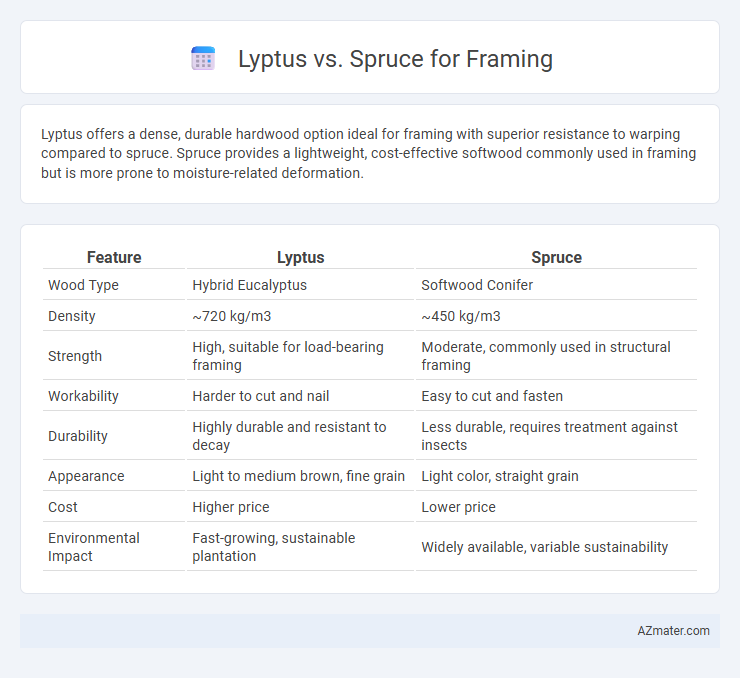Lyptus offers a dense, durable hardwood option ideal for framing with superior resistance to warping compared to spruce. Spruce provides a lightweight, cost-effective softwood commonly used in framing but is more prone to moisture-related deformation.
Table of Comparison
| Feature | Lyptus | Spruce |
|---|---|---|
| Wood Type | Hybrid Eucalyptus | Softwood Conifer |
| Density | ~720 kg/m3 | ~450 kg/m3 |
| Strength | High, suitable for load-bearing framing | Moderate, commonly used in structural framing |
| Workability | Harder to cut and nail | Easy to cut and fasten |
| Durability | Highly durable and resistant to decay | Less durable, requires treatment against insects |
| Appearance | Light to medium brown, fine grain | Light color, straight grain |
| Cost | Higher price | Lower price |
| Environmental Impact | Fast-growing, sustainable plantation | Widely available, variable sustainability |
Introduction to Lyptus and Spruce as Framing Materials
Lyptus is a fast-growing hardwood derived from Eucalyptus trees, offering high strength and durability ideal for framing applications requiring robust structural support. Spruce, a softwood commonly used in construction, provides a lightweight and cost-effective framing option with good load-bearing capacity and ease of handling. Comparing Lyptus and Spruce, Lyptus offers enhanced resistance to wear and decay, while Spruce remains a popular choice for its availability and workability in standard framing projects.
Botanical Origins and Growth Rate Comparison
Lyptus, derived from the Eucalyptus urograndis hybrid, is a fast-growing hardwood native to Brazil, known for its rapid maturation typically reaching harvestable size within 7 to 10 years. Spruce, specifically from the genus Picea, is a softwood commonly grown in temperate regions of the Northern Hemisphere, with a slower growth rate averaging 20 to 30 years to reach suitable framing dimensions. The botanical differences between Lyptus and Spruce result in distinct density and strength characteristics that influence their performance and sustainability in framing applications.
Strength and Durability: Lyptus vs Spruce
Lyptus wood exhibits higher density and strength compared to Spruce, making it more resistant to bending and impact stresses in framing applications. Spruce, while lighter, offers adequate durability but is more prone to warping and damage under heavy loads or prolonged exposure to moisture. For structural framing requiring enhanced longevity and load-bearing capacity, Lyptus provides superior performance due to its robust cellular structure and natural hardness.
Environmental Impact and Sustainability
Lyptus wood, derived from fast-growing Eucalyptus trees, offers a renewable alternative with a shorter harvest cycle compared to traditional softwoods like spruce. Spruce, widely used in framing, is generally sourced from slower-growing conifers, which may lead to longer forest regeneration periods. The production of Lyptus involves certified sustainable forestry practices, reducing deforestation impact, whereas spruce's environmental footprint depends heavily on regional forest management and certification standards.
Cost Analysis: Lyptus Versus Spruce
Lyptus wood typically costs more than spruce, largely due to its hardwood classification and sustainable harvesting practices, making it a pricier option for framing projects. Spruce, as a softwood, is widely available and less expensive, offering a cost-effective solution for large-scale framing needs. The choice between Lyptus and spruce hinges on budget constraints and project requirements, with spruce providing affordability and Lyptus offering durability at a higher price point.
Workability and Machining Properties
Lyptus offers superior workability and machining properties compared to spruce, making it ideal for framing that requires precision and smooth finishes. Its dense, uniform grain allows for clean cuts, minimal tearing, and excellent screw holding strength, enhancing structural reliability. Spruce, while lightweight and commonly used in framing, tends to splinter more easily and requires sharper tools and greater care to achieve comparable machinability results.
Resistance to Pests, Decay, and Moisture
Lyptus offers superior resistance to pests and decay compared to spruce, thanks to its denser fiber structure and natural oil content, making it less susceptible to termite and fungal attacks. Spruce, while widely used in framing, is more prone to moisture absorption, leading to higher risks of rot and insect infestation without proper treatment. Lyptus's enhanced durability in moist and pest-prone environments provides a longer-lasting framing solution, reducing maintenance and replacement costs over time.
Aesthetic Differences in Appearance and Texture
Lyptus offers a consistent, reddish-brown hue with a smooth grain that provides a sleek, modern appearance for framing projects, while Spruce displays a lighter, pale yellow tone with a more pronounced grain pattern contributing to a traditional, rustic aesthetic. The texture of Lyptus is generally denser and finer, resulting in a polished finish that enhances contemporary designs, whereas Spruce's softer, more porous texture allows for easy staining and a natural, warm look. Selecting between Lyptus and Spruce depends on the desired visual impact, with Lyptus favoring uniformity and elegance, and Spruce emphasizing natural character and versatility.
Availability and Regional Sourcing
Lyptus, a hybrid Eucalyptus species, is primarily sourced from managed plantations in South America, leading to limited availability in North American markets compared to Spruce. Spruce, abundant in the boreal forests of Canada and the northern United States, offers widespread regional sourcing with consistent supply for framing purposes. Regional sourcing of Spruce reduces transportation costs and environmental impact, making it a preferred choice in areas with established forestry infrastructure.
Best Applications: When to Choose Lyptus or Spruce for Framing
Lyptus wood offers superior density and durability, making it ideal for framing applications requiring high structural strength and resistance to wear, such as commercial buildings and heavy-load constructions. Spruce provides a lightweight, flexible option favored in residential framing due to its ease of handling, cost-effectiveness, and adequate strength for standard load requirements. Choose Lyptus for projects demanding long-term resilience and Spruce for affordable, straightforward framing solutions.

Infographic: Lyptus vs Spruce for Framing
 azmater.com
azmater.com